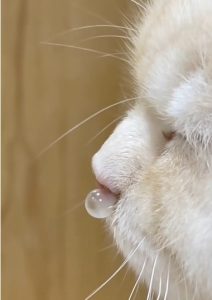Are you a cat owner who’s noticed your feline friend with bright yellow snot on its nose? Worried about its health? Let’s dive deep into the truth behind this symptom and provide practical护理 tips.

Why Does My Cat Have Yellow Nasal Discharge?
Common Causes of Yellow Nasal Discharge in Cats
Infectious Diseases
Feline herpesvirus and calicivirus are major culprits for upper respiratory infections in cats. Affected cats may have yellow nasal discharge, sneezing, coughing, watery eyes, loss of appetite, and lethargy. These viral infections are contagious, especially in multi-cat environments.
Bacterial infections, such as those caused by Bordetella bronchiseptica and Chlamydia felis, can also lead to yellow nasal discharge. Antibiotic treatment is usually required, and the specific medication should be determined by a veterinarian.
Allergic Reactions
Cats may be allergic to substances in their environment, such as pollen, dust, mold, or ingredients in their pet food. This allergic reaction can cause inflammation of the nasal mucosa, leading to symptoms like nasal discharge, sneezing, and coughing. Identifying the allergen is crucial, and veterinarians may recommend allergy testing to pinpoint the exact allergen.
Environmental Factors
Cold weather, air pollution, smoke, or strong chemical odors can irritate a cat’s respiratory tract and cause nasal discharge. This is especially true for cats living in poorly ventilated spaces.
Dental and Oral Problems
Dental issues, like periodontitis or tooth infections, can allow bacteria to enter the nasal cavity, causing nasal discharge. This is often accompanied by symptoms such as bad breath, reduced appetite, and pain.
Other Potential Health Issues
Yellow nasal discharge can sometimes signal other underlying health problems, such as chronic rhinitis, tumors, or other respiratory diseases. These conditions may present with additional symptoms like persistent coughing, rapid breathing, or weight loss.
Professional Care Tips for Cats with Yellow Nasal Discharge
Keep the Environment Clean
Regularly clean your cat’s living area to reduce the presence of allergens and irritating substances. Use dust-free and eco-friendly cat litter, and maintain a clean and appropriately humidified home environment to prevent excessive dryness.
Boost the Immune System
Provide your cat with a balanced diet rich in high-quality protein and comprehensive nutrition to enhance its immune system. Consider choosing cat food that follows the BARF (Biologically Appropriate Raw Food) diet concept, which uses natural ingredients to mimic a cat’s natural food chain.
Seek Timely Veterinary Care
If your cat’s symptoms persist or worsen, promptly take it to a pet hospital for examination and treatment. The veterinarian may recommend blood tests, X-rays, and other diagnostic procedures to ensure an accurate diagnosis and appropriate treatment plan.
Keep Your Cat Warm
When a cat has a cold, it’s important to keep it warm. Make sure your cat has a warm bed to rest in and encourage it to drink warm water.
Supplement Nutrition
During a cat’s cold, it may become weak and lose its appetite. Owners should pay attention to nutritional supplementation, providing more chicken, beef, etc., to maintain the cat’s bodily health.
Clean Nasal and Eye Discharge
Use a warm, moist cotton swab to gently wipe away any nasal or eye discharge from your cat. Be gentle to avoid harming your cat.
Conclusion
Yellow nasal discharge in cats is not normal and is usually a sign of underlying health issues. Possible causes include infections, allergies, environmental factors, and other potential diseases. As a pet owner, it’s essential to monitor your cat’s health closely, detect any abnormalities promptly, and take appropriate action. Maintaining a clean environment, boosting your cat’s immune system, and seeking timely veterinary care are all effective ways to help your cat recover and maintain good health. Let’s work together to ensure our cats live happy and healthy lives!
